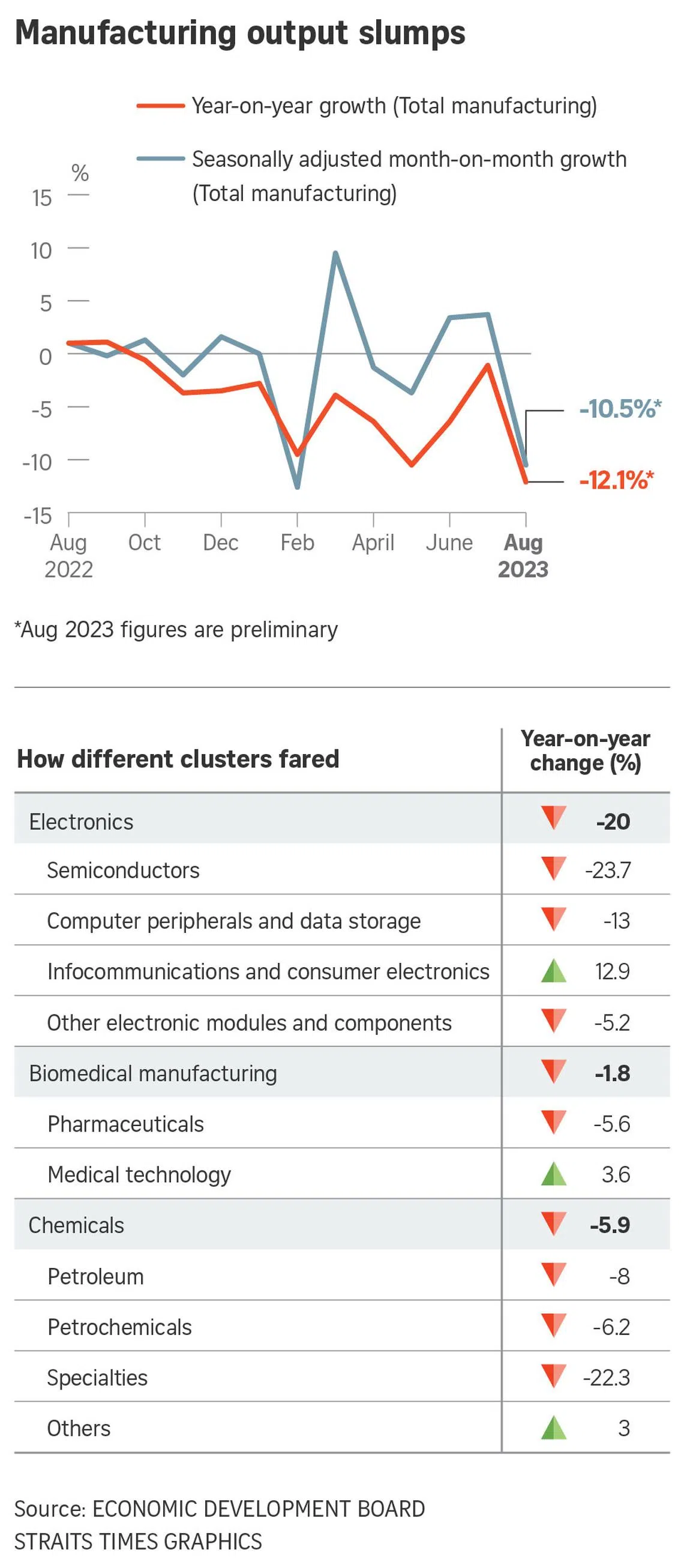Singapore factory output slumps 12.1% in August, biggest drop since 2019
Sign up now: Get ST's newsletters delivered to your inbox

The key electronics industry was August’s worst performer with production plunging 20 per cent year on year.
PHOTO: ST FILE
Follow topic:
SINGAPORE - Singapore’s manufacturing output suffered its biggest drop since November 2019 as the key electronics industry reversed back into a slump in August.
Factory production fell 12.1 per cent year on year in August, more sharply than expected, to record its 11th straight month of contraction.
Economists polled by Reuters had expected a 3.1 per cent fall after output shrank just 0.9 per cent in July, raising hopes for the start of a recovery.
Instead, manufacturing slumped across the board, except for transport engineering, according to data released by the Singapore Economic Development Board (EDB) on Tuesday. Excluding biomedical manufacturing, total output fell 16.6 per cent.
Electronics, which accounts for 45 per cent of Singapore’s total output, was August’s worst performer, with production plunging 20 per cent year on year amid weak global demand.
Within electronics, semiconductors saw the biggest fall in output of 23.7 per cent, reversing from growth of 5.1 per cent in July. It was followed by computer peripherals and data storage, which declined 13 per cent, and electronics modules and components, which dropped 5.2 per cent. Overall, electronics output contracted 9.3 per cent year on year in the period of January to August.
DBS Bank economist Chua Han Teng said that manufacturing recovery in the second half of 2023 is likely to be gradual and fragile, given the challenging global economic environment.
He added: “The electronics turnaround is still not on firm footing amid external demand challenges and risks from lingering geopolitical tensions that could still disrupt supply chains. But at least the three-month moving average trend shows that the electronics slump has likely bottomed.
“The persistent manufacturing weakness suggests that overall real GDP (gross domestic product) expansion is likely to be soft in 2023, even if we see strength from the services segments that are benefiting from the international tourism recovery and large-scale events.”
The EDB data showed the chip downturn also hit the precision engineering industry. Its output dropped 14.4 per cent due to lower production of semiconductor-related equipment.
In the biomedical industry, output declined 1.8 per cent year on year. While the medical technology segment grew 3.6 per cent due to export demand for medical devices, pharmaceutical output contracted 5.6 per cent on account of a different mix of active pharmaceutical ingredients being produced, compared with a year ago.
General manufacturing output fell 6.1 per cent over August 2022, weighed down by a decreased production of batteries and structural metal products.
The chemicals cluster was also in the red, with output falling by 5.9 per cent over August 2022. The petrochemicals and petroleum segments were generally affected by weak market demand, and production in the former was also affected by plant maintenance shutdowns.
The transport engineering cluster was the outlier, increasing production by 16.2 per cent in August, over the same month in 2022.
The marine and offshore engineering segment led the charge with an expansion of 29.4 per cent due to higher levels of activity in shipyards and increased production in oil and gas field equipment.
The aerospace segment grew 15.2 per cent as a result of higher demand for aircraft parts and more maintenance, repair and overhaul jobs from commercial airlines on the back of strong air travel demand.
On a month-on-month and seasonally adjusted basis, output fell 10.5 per cent in August, missing economists’ expectation of a 1.7 per cent contraction.

The Government in August downgraded its growth forecast for 2023 to between 0.5 per cent and 1.5 per cent amid the weak outlook for the export-driven manufacturing sector.
UOB economists Alvin Liew and Jester Koh expect Singapore’s full-year GDP growth to be 0.4 per cent in 2023, down from their previous forecast of 0.7 per cent.
They said: “While the manufacturing sector is likely to remain lacklustre, given the weak external demand, lingering tailwinds from the services-led post-Covid recovery should continue to support growth, in particular, the ongoing tourism recovery, which keeps the accommodation, transport and F&B services sectors supported.
“However, we note that services activity is still likely to moderate on tighter financial conditions in an elevated interest-rate environment and easing of domestic and regional labour-market conditions.”


